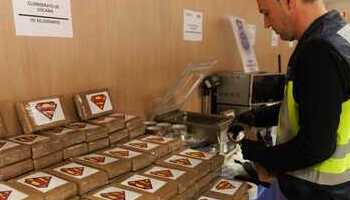Spanish police have uncovered Europe’s largest-ever cocaine-producing laboratory, but despite such finds, cocaine production on the continent likely remains in its infancy.
Authorities officially announced on April 13 a previously reported operation last month that dismantled a facility able to produce an estimated 200 kilograms of cocaine per day, dubbing it “Europe’s largest cocaine base processing laboratory” to date.
The facility, located in the northwestern area of Galicia near Spain’s Atlantic coast, reportedly operated around the clock. The lab refined coca base, a concentrated paste used in the first stage of cocaine production, into cocaine hydrochloride, the frequently consumed white powdery substance.
Spanish police stated the lab revealed “the existence of a new trend in cocaine trafficking, in which the unprocessed drug is exported to be chemically processed in clandestine laboratories in its destination countries.”
SEE ALSO: Europe Narco-Sub Heralds More to Come
Police uncovered large amounts of chemicals used to produce cocaine and 151 kilograms of cocaine hydrochloride. As much as 1.3 tons of coca base was also found, which Spain claimed was the largest-ever seizure outside of Latin America.
Eighteen people have been arrested, including a number of Colombian and Mexican citizens who allegedly assisted in the cocaine production process.
InSight Crime Analysis
Notwithstanding the size of the recently discovered laboratory, large-scale cocaine production in Europe remains far off.
European authorities across the continent have previously busted labs that processed cocaine base into hydrochloride, challenging the Spanish police’s notion that the trend is new.
Last year, a smaller lab was discovered in Spain, while authorities in the Netherlands previously uncovered a series of labs, each with the capacity to produce 100 to 200 kilograms of cocaine per day.
Laurent Laniel, the principal scientific analyst at the European Monitoring Centre for Drugs and Drug Addiction (EMCDDA), pointed out that the Dutch labs rivaled the scale of the one found recently in Galicia.
“I don’t know whether this lab, as they claim, is actually the biggest ever found,” Laniel told InSight Crime.
Facilities using similar processes have also been discovered all around Europe, appearing in Ireland, Italy, Portugal, and Belgium, among others. But they have been much smaller in scale, Laniel said.
European authorities have frequently busted laboratories that chemically extract cocaine from other products in which it’s hidden. But the increasingly common discoveries of production labs suggest drug traffickers see significant advantages in exporting coca base to Europe instead of cocaine.
Coca base is much cheaper to buy in Latin America than finished cocaine, mitigating the impact of losses if the substance is seized.
And while South American labs are often rudimentary, traffickers’ access to higher-quality chemicals and equipment in Europe could also mean the production of a higher-quality product, Laniel told InSight Crime.
SEE ALSO: Latin American Experts Help European Gangs Produce Cocaine at Home
Transnational groups might be recognizing these opportunities, as Spanish police claimed that the Mexicans and Colombians arrested were part of broader networks. One of the Mexican suspects was identified as a guarantor in charge of ensuring the operation ran smoothly, presumably for an individual or group with a stake in the cocaine lab.
But there is no firm evidence linking Latin American groups with actual cocaine production in Europe, and most transatlantic traffickers remain focused on cocaine importation.
Nearly three-quarters of all cocaine seized around the world in 2020 was seized in Latin America and the Caribbean, according to the United Nations Office on Drugs and Crime (UNODC)’s Global Report on Cocaine 2023. Furthermore, it is cocaine hydrochloride that continues to flood European ports, with Belgium’s port of Antwerp seizing a record 110 tons of cocaine in 2022.

